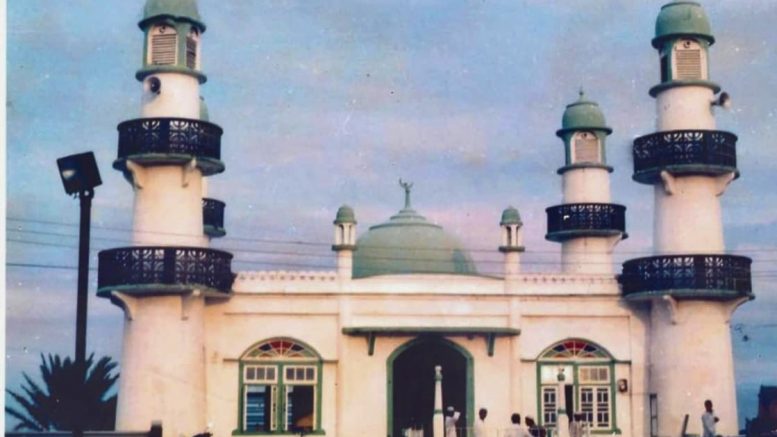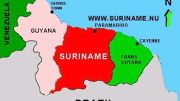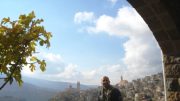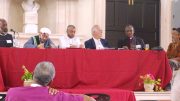Evidence shows that since 1863, Muslim congregations registered anjumans, jamaats, associations and mosques in Guyana to address the then-existing Muslim communities’ spiritual needs. Further evidence suggests there were also informal, unregistered places of assembly for worship. There is documentation that the founding of the Number 78/79 Masjid (Mosque)was in 1863, according to an article to commemorate the Centennial of the Masjid published in the Daily Chronicle on August 25, 1963. Yet, there are still some unanswered questions. There is no conclusive evidence to determine which mosque was the first constructed in Guyana.
There are a variety of claims to being the first mosque built in Guyana. For example, was it during the era of slavery; the Philadelphia Mosque on the East Bank of the Essequibo, which many claimed was “built in the 1860s or the 1863 # 78/79 Mosque? This article suggests
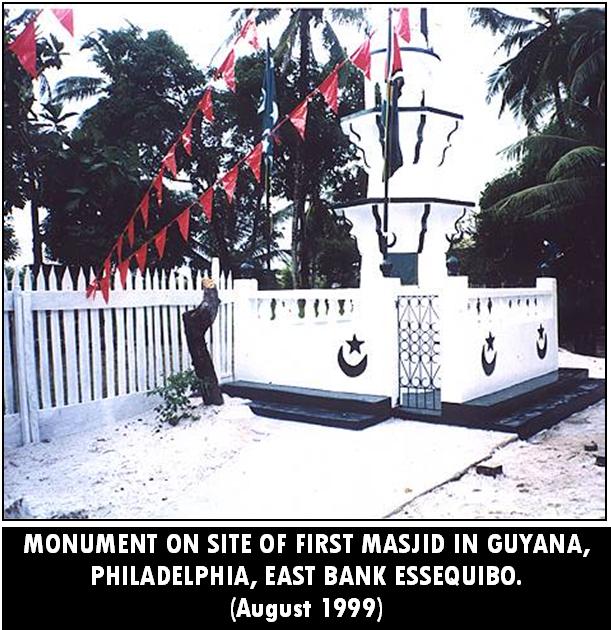
Monument on Site of Claimed First Masjid in Guyana Philadelphia East
In 1999 several Muslim groups gathered at Philadelphia, Guyana, to “marked the site” where Guyana’s indentured Muslims built the first masjid (on the South American continent) in the 1860s.” These groups are the leading Muslim associations in Guyana, the Guyana United Sadr Islamic Anjuman, the Anjuman Hifazatul-E-Islam, the Central Islamic Organisation of Guyana (CIOG) and the Guyana Islamic Trust (GIT),
During the ceremony, speakers noted that “with more work and scholarship, … studies can be undertaken to bring more clarity and accuracy in learning more about Guyana’s first mosques.”
One certainty is that since the second wave of Muslims started from India, Afghanistan and what is now Pakistan to Guyana in 1838, Muslims have formed several organisations and built many mosques to preserve their faith, history and culture.
Subrati, with his younger brother, 19-year-old Suhabuth (sons of Rumul), arrived in Guyana on board the Syria in May 1869 from Calcutta. On his immigration certificate, his name is spelt “Soberauthy.”
The brothers’ names would eventually take on several spellings on various documents relating to them; “Sohabat, Sohabet, and Shahadat, Subrati.” Spelling variation was quite common in Guyana. It is impossible to record Urdu, Arabic or Hindi names using an English alphabet, and mistakes were expected, given that oral transmission was the basis of transcribing terms. Further, many Hindustani immigrants ended up not carrying their father’s surname. For example, if the child registered as Abdul Gaphur, which is one first name, then that was the one name the child carried, basically, his father’s first name. Cultural barriers, especially language, left us a legacy of people with one name and not inheriting their fathers’ surnames.
They were indentured to Eliza and Mary (Skeldon) Plantation, a large sugar plantation in upper Corentyne with a strong Muslim presence. As a result, Muslims settled near each other, with clusters of Muslim communities developing over time.
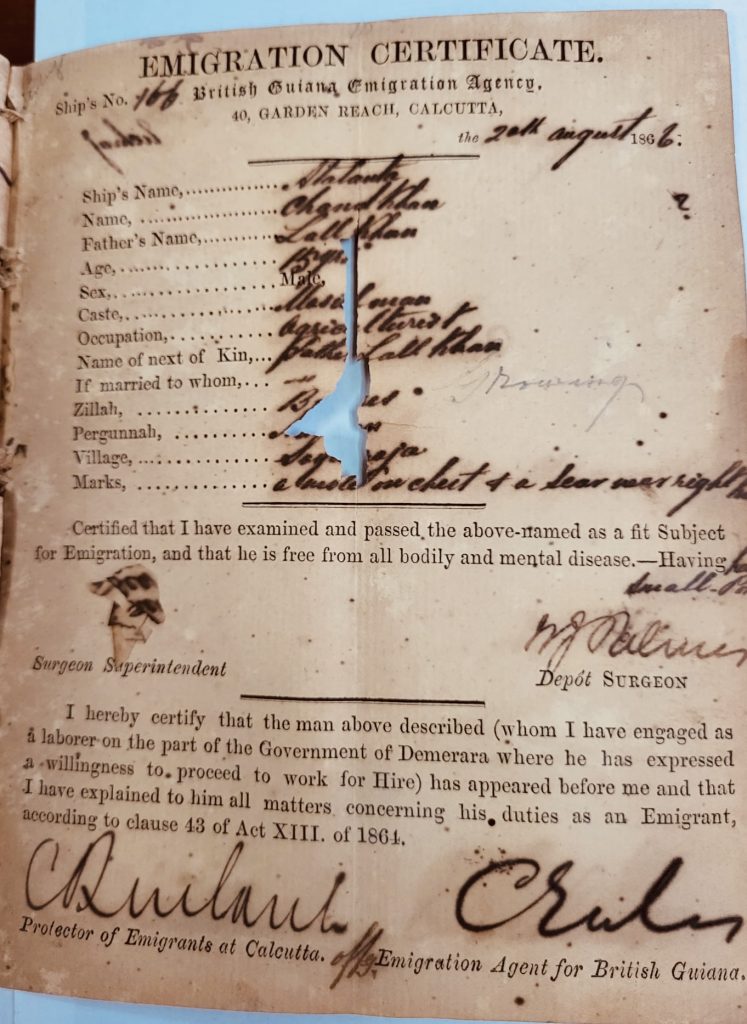
Chand Khan Immigration Certificate
Our research has concluded that the Philadelphia, East Bank Essequibo, mosque cannot be the first built in Guyana. The timeline of its reported construction is off compared to the arrival of its founder, Hazrat (Mr) Chand Khan, in Guyana. Chand was in his teenage years upon his arrival in British Guiana in November 1866 on board the Atalanta with his parents, Hazrat Lall Khan and Woolfat (Ulfaat Begum/Mrs) from Benares, when he was 15 years old. Along with his parents, Chand was indentured to Plantation Uitvlugt.
Chand Khan was said to arrive in Guyana in 1839 on “the Atlantic.” However, we have yet to find a record of such a ship arriving in Guyana that year from India. Several years after 1838, when immigration from India commenced, there was a temporary stop and immigration restarted after improvement was sought to ensure passenger well-being. After the initial arrival of the Whitby and Hesperus in 1838, immigration from India resumed in 1845.
According to Archives records and Mr Evan Persaud1, an authority on Indian immigration to Guyana, the Atalanta arrived four times in British Guiana: (1) April 13 1862; (2) November 22 1866; (3) May 21 1874; (4) May 1 1875. The Atalanta 1866: 388 landed, of whom 386 were allotted to 15 sugar plantations: (1) Met-en-Meerzorg; (2) Uitvlugt; (3) Stewartville; (4) Anna Catherina; (5) Haarlem; (6) Malgre Tout; (7) Nismes; (8) Providence (East Bank Demerara); (9) Houston; (10) Bel Air; (11) Mon Repos; (12) Annandale; (13) Nonpareil; (14) Cove and John; and (15) Wales. Twenty-five Hindustanis were allotted to Uitvlugt: 19 men, five women and one boy. Among them were young Chand Khan and his family. No one went to Vergenoegen.
This same Chand Khan # 166 from Benares, not Hyderabad, was the father of Ameeran, who was born in Philadelphia, ECE, on December 14, 1889, to Chand Khan (166/Atalanta/1866) and Mooradun, who was an Indian immigrant that came on the Sydenham in 1864.
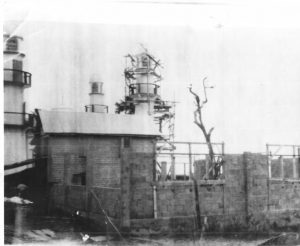
78 Masjid
However, the Number 78 Mosque, built initially at #79 Village and “founded in 1863”, also leaves some discrepancies because Soberauthy (Subrati) and his brother arrived in Guyana in 1869. This fact leaves some questions, was the 78 Mosque founded about 1870 after the brothers’ arrival? Or was the land acquisition process commenced in 1863 by the other founding members like Khadmi, Shahabuddin, Ishmael and Wajid Ali?
Guyana’s early ulema (those who had some knowledge of Islamic sacred law) were geographically dispersed and spanned from Essequibo to Demerara and Berbice. Among the leading ulema of the time were Al-Haj Hazrat Ramjohn (Ramazan) and Hazrat Mohammad Ahmad Nasir.
l
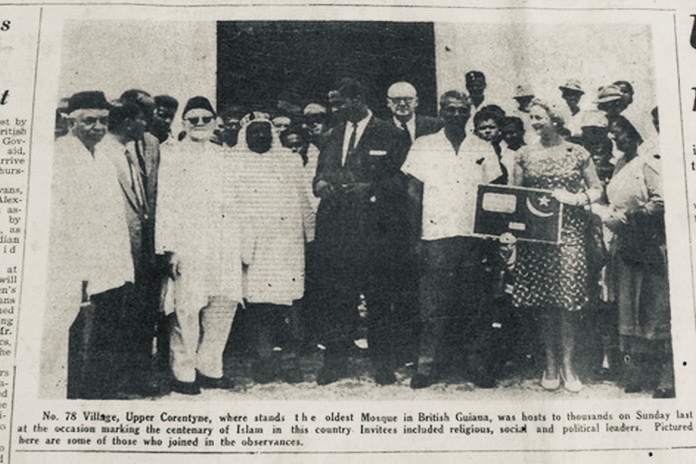
Group picture at 100th commemoration of 78 masjid (Daily Chronicle)
The Centennial commemoration of the # 78 Mosque in 1963 was reported in the Daily Chronicle on August 25, 1963. In this edition of the Daily Chronicle, a spokesperson of the celebration said, “Extensive and exhaustive research has revealed that the mosque was built in 1863 by Sohabeth Subrati, father of the late Moulvi Ibrahim; Ishmile Shahadeen, Wajid Ally and Khadmi, mother of Messrs, Dookie and Sankar. They “showed keen interest in Islam, and it was by their instrumentality that they have been fortunate to acquire a piece of land and built a small mosque.”
Khadmi’s story is of great interest. She comes from a pious and humble Muslim family; her father was also a Majee(Meah, Imam or prayer leader of a local mosque). Khadmi married Ramessar, an Indian-born Brahmin, who converted to Islam and agreed to raise their children as Muslims. They had two sons, Susankar (Maula Baksh) and Dookie (Khoda Baksh). Ramessar was a goldsmith in Skeldon (perhaps the first Hindustani goldsmith) in the 1880s after he returned from India in 1880. In 1880 Ramessar returned with his family to India. However, they abruptly returned to Guyana after his relatives discovered he had become a Muslim. Ramesar’s On the birth certificate of his grandson, Aminul Ahmad Sankar, Ramessar is recorded as his “grandfather”, a “goldsmith from # 79.” From Susankar, the name changed to Sankar from this period.
It is worth mentioning that Sankar’s wife, Sakinatul, was the eldest sister of Kabul (Kabil) Khan, Nur Khan, Shehzaadi and Zainab. Zainab Khatoon was married to Ibrahim Majee, a son of Sohabat. Shehzaadi Khatoon was married to Hazrat Abdool Rahaman from #79. The two brothers were Nur Khan and Kabil Khan. Kabil Khan’s wife, Imaman, was from Tushen. So it demonstrates yet another piece of historiography: from one end of Guyana to the other, Corentyne, to the Essequibo Islands, families were connected. And I speak of all Muslim Guyana in this context. It’s common to seek those with a shared affinity for a minority community to survive and grow.
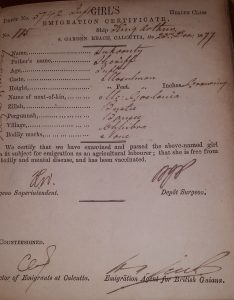
Goolmani and Sakinatul Immigration records
Ghanim Khan, a well-known Guyana cricketer, was one of Kabil’s sons. Their mother, Goolmani Khatoon, and her infant child, Sakinatul, were kidnapped from Benares, India, in 1877, sent on board the King Arthur, and indentured to Eliza and Mary. Another one of Kabil’s sons, Imamuddin, was President of the # 78 Jamaat in the 1960s.
Soberauthy married Rahiman, a Hindustani native who migrated to Guyana in 1867, on board the Clarence to Skeldon. Among their children were Karim Baksh (1880), Abdul Karim (1882), Ibrahim (1886), Haliman (1888), and Shakuran (1890) and all were born at the Number 78 Village. We know that two of his sons, Abdul Karim and Ibrahim, were Imams. Abdul Karim died at Peter Hall, EBD, on November 19, 1935.
The original site of the 78 Mosque was at Number 79 Village, where Mohammed Ezammudeen, a great-grandson of Sohabat, lives today. The original mosque was moved from #79 to its current location at # 78 Village.
Upon his return from Makkah, the Middle East and India, Al Haj Ramjohn (Ramazan) undertook enormous efforts to modernise the masjid. He garnered community support to build one of the most beautiful mosques in Guyana. He didn’t hesitate to go deep into his pockets to finance the expensive project. Like Al-Haj Mohammed Ballee (Wallee), his home hosted Maulanas from Pakistan, Imams, Majees, Ustads, dignitaries, Ambassadors and visitors from Guyana, the Caribbean, Pakistan and elsewhere.
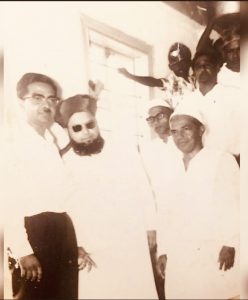
Haji Balee Haji Shakoor and Maulana 1950
In 1950, Maulana Abdul Aleem Siddiqi became one of the first illuminary Islamic scholars to visit Number 78 Village. He was hosted by Al-Haj Ramazan. Accompany Maulana Siddiqi was his Secretary, Hazrat Fazlur Rahaman Ansari, who stayed at Al-Haj Ramazan’s home. Hazrat Fazlur Ansari returned to Guyana in 1967.
In 1968, Maulana Noorani, son of Maulana Siddiqi, visited Skeldon, and Al-Haj Ballee (Wali) hosted him at his home. Al-Haj Ballee was hosted by the Maulana when he visited Karachi. Haji Ballee was an Ustaz of Arabic and Urdu who trained and groomed several Imams who eventually moved to North America. Al-Haj Balle also was instrumental in building relationships between the Muslims of Guyana and Suriname. Haji Ballee, Haji Ramjohn and Sardar Imtiaz Majee were some of our legendary nation builders. They were well known in Suriname at Plantation Waterloo, where they also carried out Islamic work.
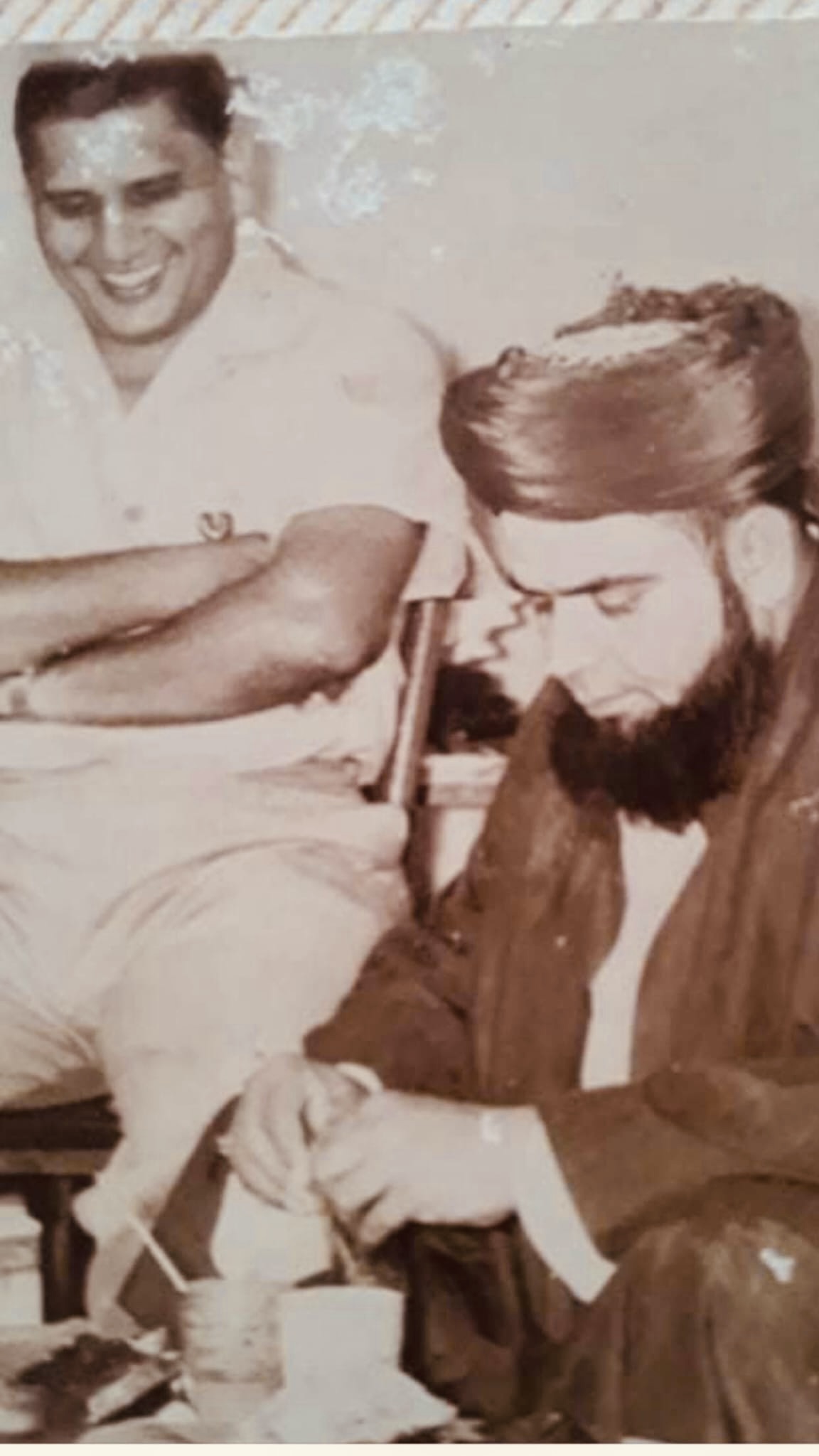
Imamoudeen Khan, a former President of 78 Jammat and Maulana Noorani, 1968
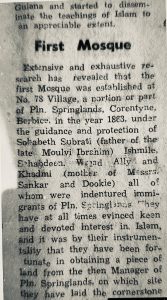
A striking piece of information not elaborated on in the 1963 article was a subheading, “Centenary of Islam, How the first Muslim Came,” and there was a subheading, “First Mosque.” So did the elders of 1963 already validate that the Number 78 Village Mosque was the first in Guyana? Then there was another piece of information. The picture’s caption reads, “No. 78 Village, Upper Corentyne, where stands the oldest Mosque in British Guiana, was hosts to thousands on Sunday last at the occasion marking the centenary of Islamic in this country.”
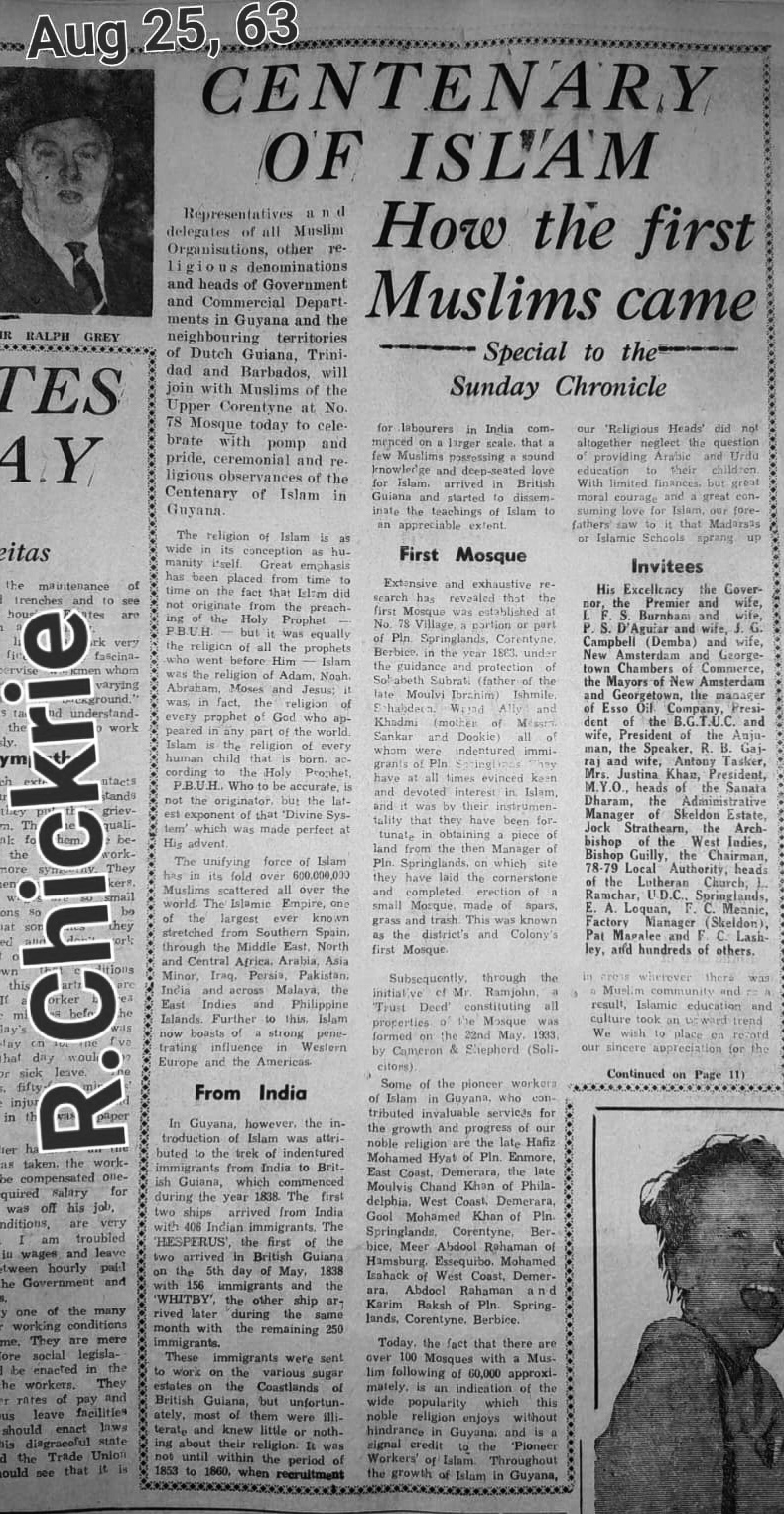
Daily Chronicle
According to Mohammed Ezammudeen, a great-grandson of Sohabat, “Sohabeth Subrati,” referenced in the 1963 article, isn’t the name of one person but the names of the two brothers who came from India. And indeed, documentation has proven him correct. So who are the children of Soberauthy? Also, I continue to investigate the other founders, Khadmi, Ishmile, Shahabeen, and Wajid Ally. Research continues to bring more light and clarity to the founding of the 78 Masjid, and I welcome any help from the public.
Since its original construction, the mosque underwent several reconstruction phases and modernisation. Sadly, the ornate mosque in white and aqua blue/green was reconstructed to erect a megastructure about two decades ago, which lacks aesthetic appeal.
1 – Evan Persaud was interviewed on March 24, 2023.
Gratitude
I wish to express my deepest gratitude to Ms Melissa Jones of the Walter Rodney Archives of Guyana, CaribbeanMuslims.com, Deen Ameerullah (Great Grandson of Gool Mohamed Khan, founder of the Queenstown Mosque 1895), Uncle Saleem Ballee, Uncle Emo, and so many more people who have shared their knowledge and historical artefacts with me.
